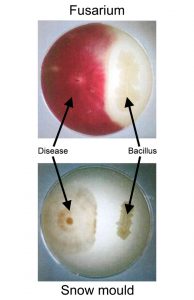‘Maintaining healthy rhizosphere conditions is key after warm winter’
Related Articles
With this year’s wet and warm winter weather creating the perfect conditions for turf diseases such as fusarium, snow mould and anthracnose to thrive, maintaining healthy rhizosphere conditions is the first step in preventing infections from detracting from turf performance and appearance.
That is the advice from Richard Brown of Germinal who recommends that an early season application of a rhizobacteria enhanced fertiliser will not only provide plants with vital nutrients, but will also promote healthy root development and protect against soil borne seedling diseases. “Apart from the occasional, brief period of colder weather, many parts of the UK experienced unseasonably wet and warm weather throughout winter,” he said.
“Whether this is simply a short-term weather pattern or a sign of things to come only time will tell, but turf professionals need to be wary of the dangers that these conditions can have on turf quality and performance.”

Mr Brown therefore emphasises the need for turf professionals to give extra consideration to soil health and to pay particular attention to the vitality of the rhizosphere.
“Plant growth and health is influenced by many abiotic and biotic factors, with the rhizosphere – the thin layer of soil immediately surrounding plant roots – especially important for root activity and metabolism,” Mr Brown explained. “This zone is populated by an abundance of microorganisms including beneficial pathogens – rhizobacteria – and harmful pathogens including nematodes and the soil borne fungi which cause diseases such as fusarium, snow mould and anthracnose.”
Of the beneficial bacteria found in the rhizosphere, the Bacillus genus is the most abundant. “The plant growth promoting activity of some members of the Bacillus genus has been known for many years,” Mr Brown added, “with Bacillus subtilis and Bacillus amyloliquefaciens the most commonly used commercially available soil enhancing bacteria.
“All Bacillus strains provide some protection from harmful pathogens by colonating and growing on roots, but only specific strains cover the entire root surface from top to tip to create a truly impenetrable barrier.”
Two strains of rhizobacteria which provide protection across the entire root surface are B.subtilis E4-CDX and B.amyloliquefaciens R6-CDX. “Both of these strains provide full root protection and prevent soil borne diseases from infecting grass plants and detracting from the appearance and vigour of sports pitches and fine turf areas. When applied in a timely, proactive manner they can even mitigate the need for expensive fungicide programmes by preventing the diseases from taking hold.”
B.subtilis E4-CDX and B.amyloliquefaciens R6-CDX are found exclusively within Compo’s Fertilis compound and Vitanica liquid fertiliser ranges.
“When combined with liquid and granular fertilisers, B.subtilis and B.amyloliquefaciens provide a readily-available source of nutrients in combination with a proven disease inhibition effect,” Mr Brown continued. “By applying products such as Fertilis Swing, Fertilis Speed and Vitanica RZ to well-aerated soils with a base temperature of 10oC or higher, these specialist fertilisers provide grass swards with three distinct benefits: improved wear-tolerance and visual appearance along with improved disease resistance for up to 42 days.”

























